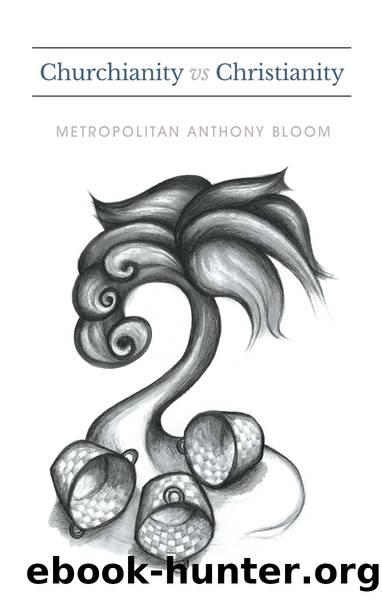Churchianity vs Christianity by Bloom Met. Anthony;

Author:Bloom, Met. Anthony;
Language: eng
Format: epub
ISBN: 9780881415872
Publisher: Saint Vladimir's Seminary Press
Published: 2017-05-16T00:00:00+00:00
The Tragedy Beyond the Beauty
Beyond these we must see the rough, rude cross of Calvary. . . .
6
Beyond the Beauty, the Tragedy
april 26, 1990
Many years ago a historian of Church art called [Igor] Grabar wrote an essay on the architecture of the Church, and in this essay he tried to showâand I think convincinglyâthat the architecture of the Church was meant to convey to people what the world could be if it were built according to rules of harmony, of true beauty, not seeking for aesthetics, but for meaning. And in the same manner research has been done about the cathedral in Chartres and it has been proved quite conclusively that it was built in such a way as to correspond to musical scales and harmonies, again speaking of beauty, of harmony, as revealing what the world could and should be if we, Christians, to whom God has revealed so much about his ways and his thoughts, tried to build a world worthy of man and worthy of him. And again the same or a similar feeling struck me when I first went to Russia and when, having traveled through streets that were poor and between houses that were drab, among the grayness of life, I walked into one of the churches and was suddenly confronted with unimaginable beautyâthe beauty of the structure itself, the greatness of the screen, the individual beauty of icons, and within it the beauty of the celebration, and above and beyond it all, the response of a crowd of people of all types, all ages, who responded to it and were transformed, transfigured, even for a short moment, by what they perceived.
Later they would come out of this church and walk in the streets among the drab houses, the grayness of life, with all the heaviness of their condition. But what they had experienced they could not erase from themselves, from their innermost self, because, as the French writer [Leon Bloy] has put it, âsuffering passes; to have suffered never passes.â And one could say, the actual experience passes away, but to have gone through an experience never passes away. We are made into other people through an experience once perceived even if we forget about it later, even if consciously we are not aware of what happened to us once upon a time. And in that sense beauty, harmony, perfection of structure are elements that give us a message, and if in the church we learned to be completely open to the message that it conveys to us, we would leave the church every timeâwe would leave a service, go back into our ordinary lifeârenewed, different; however, on one condition: that beauty should not acquire for us a value of its own; that beauty should be conducive to the understanding of meaning, consciously and beyond our conscious mind; that beauty should not be made into aesthetics. And I could illustrate, describe this sentence of mine by a remark that I heard once. Someone was
Download
This site does not store any files on its server. We only index and link to content provided by other sites. Please contact the content providers to delete copyright contents if any and email us, we'll remove relevant links or contents immediately.
| Amish | Catholicism |
| Christian Science | Jehovah's Witness |
| Mennonite | Messianic Judaism |
| Mormonism | Orthodoxy |
| Protestantism |
Under the Banner of Heaven: A Story of Violent Faith by Jon Krakauer(1409)
The Early Centuries - Byzantium 01 by John Julius Norwich(1357)
Taken by J. C. Owens(1275)
In Spirit and Truth (In Spiritu Et Veritate Series) by Reed Zoe(1260)
The Amish by Steven M. Nolt(1250)
Play It as It Lays by Joan Didion(1206)
The Apogee - Byzantium 02 by John Julius Norwich(1159)
The Last Man in Russia by Oliver Bullough(1096)
A History of the Amish by Steven M. Nolt(978)
Tears of the Silenced: A True Crime and an American Tragedy; Severe Child Abuse and Leaving the Amish by Misty Griffin(958)
Leaving the Witness by Amber Scorah(948)
Fallen by unknow(925)
David Sedaris Diaries by David Sedaris(910)
The Angel of Forest Hill by Cindy Woodsmall(898)
The Best of Amish Cooking by Phyllis Pellman Good(881)
The Ariana Trilogy by Rachel Ann Nunes(877)
Escape by Carolyn Jessop & Laura Palmer(874)
Deep Blue by unknow(867)
Primal: A Quest for the Lost Soul of Christianity by Mark Batterson(851)
